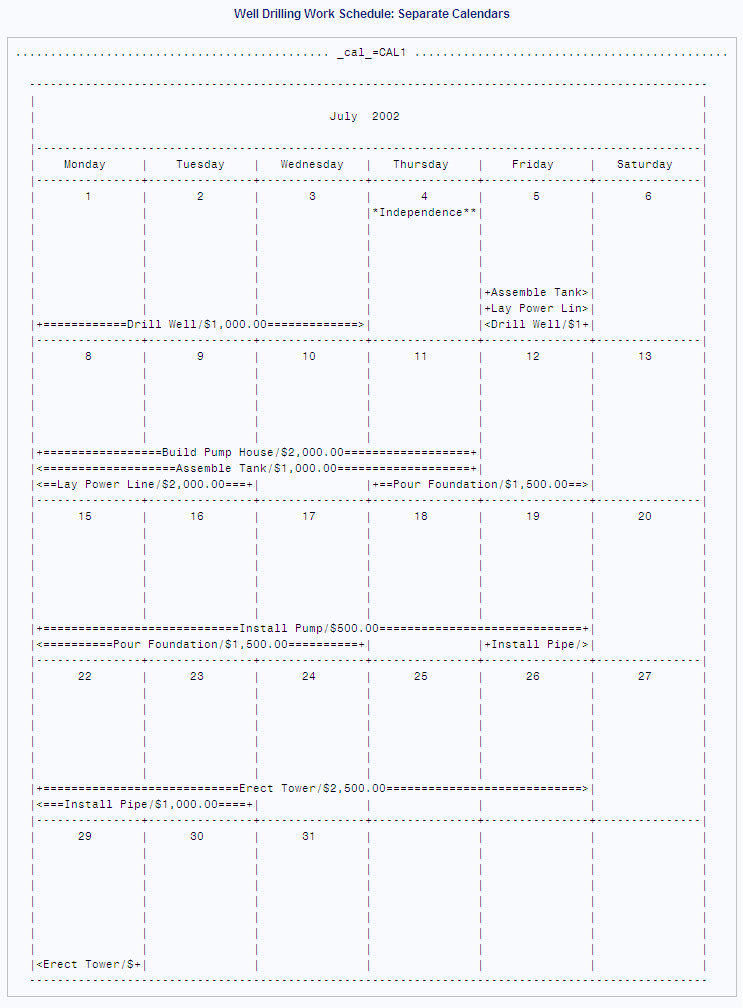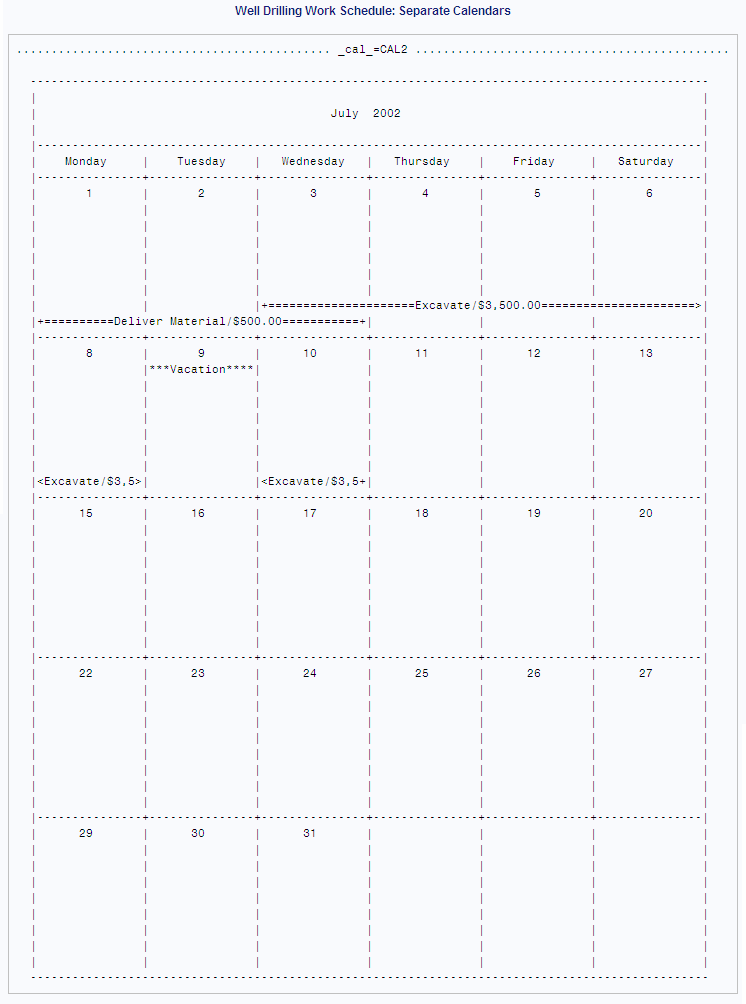CALENDAR Procedure
- Syntax

- Overview
- Concepts
- Results
- Examples
 Schedule Calendar with Holidays: 5-Day DefaultSchedule Calendar Containing Multiple CalendarsMultiple Schedule Calendars with Atypical Work Shifts (Separated Output)Multiple Schedule Calendars with Atypical Work Shifts (Combined and Mixed Output) Schedule Calendar, Blank or with HolidaysCalculating a Schedule Based on Completion of Predecessor TasksSummary Calendar with MEAN Values by ObservationMultiple Summary Calendars with Atypical Work Shifts (Separated Output)
Schedule Calendar with Holidays: 5-Day DefaultSchedule Calendar Containing Multiple CalendarsMultiple Schedule Calendars with Atypical Work Shifts (Separated Output)Multiple Schedule Calendars with Atypical Work Shifts (Combined and Mixed Output) Schedule Calendar, Blank or with HolidaysCalculating a Schedule Based on Completion of Predecessor TasksSummary Calendar with MEAN Values by ObservationMultiple Summary Calendars with Atypical Work Shifts (Separated Output)
Example 3: Multiple Schedule Calendars with Atypical Work Shifts (Separated Output)
| Features: |
|
Producing Different Output for Multiple Calendars
This example and Multiple Schedule Calendars with Atypical Work Shifts (Combined and Mixed Output) use the same input data for multiple calendars to produce
different output. The only differences in these programs are how
the activities data set is sorted and how the OUTPUT= option is set.
Program
libname well 'SAS-library';
data well.act; input task & $16. dur : 5. date : datetime16. _cal_ $ cost; datalines; Drill Well 3.50 01JUL02:12:00:00 CAL1 1000 Lay Power Line 3.00 04JUL02:12:00:00 CAL1 2000 Assemble Tank 4.00 05JUL02:08:00:00 CAL1 1000 Build Pump House 3.00 08JUL02:12:00:00 CAL1 2000 Pour Foundation 4.00 11JUL02:08:00:00 CAL1 1500 Install Pump 4.00 15JUL02:14:00:00 CAL1 500 Install Pipe 2.00 19JUL02:08:00:00 CAL1 1000 Erect Tower 6.00 20JUL02:08:00:00 CAL1 2500 Deliver Material 2.00 01JUL02:12:00:00 CAL2 500 Excavate 4.75 03JUL02:08:00:00 CAL2 3500 ;
data well.hol; input date date. holiday $ 11-25 _cal_ $; datalines; 09JUL02 Vacation CAL2 04JUL02 Independence CAL1 ;
data well.cal;
input _sun_ $ _sat_ $ _mon_ $ _tue_ $ _wed_ $ _thu_ $
_fri_ $ _cal_ $;
datalines;
Holiday Holiday Workday Workday Workday Workday Workday CAL1
Holiday Halfday Workday Workday Workday Workday Workday CAL2
;
data well.wor; input halfday time5.; datalines; 08:00 12:00 ;
proc sort data=well.act; by _cal_ date; run;
options formchar="|----|+|---+=|-/\<>*";
proc calendar data=well.act
holidata=well.hol
caledata=well.cal
workdata=well.wor
datetime;
calid _cal_ / output=separate;
start date; dur dur;
holistart date; holivar holiday;
outstart Monday; outfin Saturday;
title1 'Well Drilling Work Schedule: Separate Calendars'; format cost dollar9.2; run;
Program Description
Create the activities data set and identify separate calendars. WELL.ACT is a permanent SAS data set that contains
activities for a well construction project. The _CAL_ variable identifies
the calendar that an activity belongs to.
data well.act; input task & $16. dur : 5. date : datetime16. _cal_ $ cost; datalines; Drill Well 3.50 01JUL02:12:00:00 CAL1 1000 Lay Power Line 3.00 04JUL02:12:00:00 CAL1 2000 Assemble Tank 4.00 05JUL02:08:00:00 CAL1 1000 Build Pump House 3.00 08JUL02:12:00:00 CAL1 2000 Pour Foundation 4.00 11JUL02:08:00:00 CAL1 1500 Install Pump 4.00 15JUL02:14:00:00 CAL1 500 Install Pipe 2.00 19JUL02:08:00:00 CAL1 1000 Erect Tower 6.00 20JUL02:08:00:00 CAL1 2500 Deliver Material 2.00 01JUL02:12:00:00 CAL2 500 Excavate 4.75 03JUL02:08:00:00 CAL2 3500 ;
data well.hol; input date date. holiday $ 11-25 _cal_ $; datalines; 09JUL02 Vacation CAL2 04JUL02 Independence CAL1 ;
Create the calendar data set. Each
observation defines the work shifts for an entire week. The _CAL_
variable identifies to which calendar the work shifts apply. CAL1
uses the default 8-hour work shifts for Monday through Friday. CAL2
uses a half day on Saturday and the default 8-hour work shift for
Monday through Friday.
data well.cal;
input _sun_ $ _sat_ $ _mon_ $ _tue_ $ _wed_ $ _thu_ $
_fri_ $ _cal_ $;
datalines;
Holiday Holiday Workday Workday Workday Workday Workday CAL1
Holiday Halfday Workday Workday Workday Workday Workday CAL2
;Create the workdays data set. This
data set defines the daily work shifts that are named in the calendar
data set. Each variable (not observation) contains one daily schedule
of alternating work and nonwork periods. The HALFDAY work shift lasts
4 hours.
Sort the activities data set by the variables that contain
the calendar identification and the starting date, respectively. You are not required to sort the holidays data set.
Set the FORMCHAR option.Setting
FORMCHAR to this exact string renders better HTML output when it is
viewed outside of the SAS environment where SAS Monospace fonts are
not available.
Create the schedule calendar. DATA=
identifies the activities data set; HOLIDATA= identifies the holidays
data set; CALEDATA= identifies the calendar data set; WORKDATA= identifies
the workdays data set. DATETIME specifies that the variable specified
with the START statement contains values in SAS datetime format.
Print each calendar on a separate page. The CALID statement specifies that the _CAL_ variable
identifies calendars. OUTPUT=SEPARATE prints information for each
calendar on separate pages.
Specify an activity start date variable and an activity
duration variable. The START statement
specifies the variable in the activities data set that contains the
activity starting date; DUR specifies the variable that contains the
activity duration. START and DUR are required for a schedule calendar.
Retrieve holiday information. HOLISTART
and HOLIVAR specify the variables in the holidays data set that contain
the start date and name of each holiday, respectively. HOLISTART is
required when you use a holidays data set.

